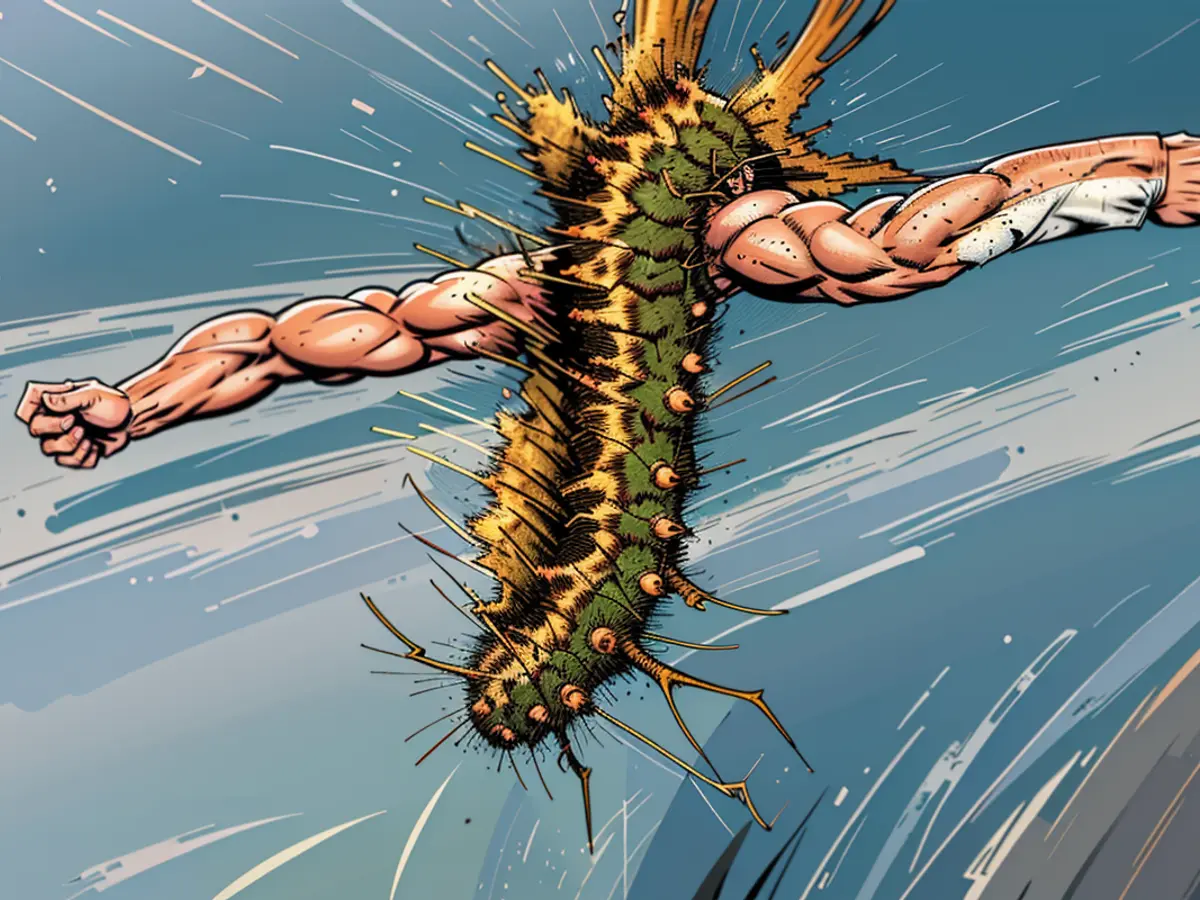Dangerous caterpillars from processionary moths - TV actress Katja Danowski shares how her dog Frido narrowly escaped death.
How could there not have been a warning sign on the walking trail? Katja Danowski still questions this two months later, after her dog, Frido, nearly died in the Piedmont mountains. Neither she nor her partner Samuel had seen the white balls in the trees - the nests of the processionary caterpillar. In Germany, signs warn of "potentially dangerous skin and respiratory tract allergies" in contaminated forest areas. They suggest staying away from the nests, avoiding contact with caterpillars, and keeping dogs on a leash. "That seems too simple," says actress Katja Danowski.
Droplets of foam came from Frido's mouth and hit the ground.
The trio was returning from a short walk to their vacation home when Katja Danowski noticed the caterpillar on Frido's snout. It had a vibrant blue-black color with orange spots, with a covering of fine white hairs. "Oh, that's pretty," she murmured, picked it up with her finger, and placed it on a stone by the side of the road. They had only walked a few more meters when the dog began to make unusual slurping noises. Its tongue soon protruded from its mouth, swelling up. "It looked like neon orange," recalls Samuel. They searched for "poisonous caterpillar in Italy" - pine processionary moth. A relative to the active oak processionary moth in Germany.
Katja cradled Frido in her arms, they ran back to the vacation home, Katja Danowski tripped on the well, used the foam from the dog's mouth to clean his muzzle, then hastened to the neighbors to arrange a car. "I was left alone with him for a bit," Samuel recalls. "Foam gathered around his mouth, looking like snow, and kept dripping for a large pool on the ground as I disturbed it constantly." They drove in the neighbor's car to the veterinary clinic 20 kilometers away in Domodossola. Frido, held by Katja Danowski, was gasping, groaning, and barking.

The veterinarian knew what to do right away; this wasn't the first dog she treated. However, she declared it was the worst case she'd ever seen. In a single hour, Frido's tongue had transformed from violet to black and protruded from his mouth as a thick pad. The veterinarian injected cortisone into his front paw, and the owners were sent away - there was nothing more they could do, she said.
Skin rash with itching on hands, forearms, and neck
Despite their shock, Katja and Samuel wandered through town, eventually visiting a restaurant. The waitress questioned Katja about her condition. Danowski examined herself, finding red pustules covering her hands, forearms, and neck. All the areas where she had touched Frido's fur. "You've touched a 'Processionaria,'" said the waitress. "I'm taking you to the hospital. You could have an anaphylactic shock." A quarter hour later, Katja sat wheelchair-bound in the emergency room, high-dose cortisone infusing into her arm vein.

Everyone in the area knew about the danger. The area had been contaminated for years. There are several species of processionary moths dangerous to humans and animals. The pine processionary moth, prevalent in southern countries in March, and the oak processionary moth, whose larvae emerge in April and pose the highest threat from late May to mid-July. Due to climate change, there have been outbreaks in Germany, with the first detected oak infestations in Hamburg in 2011.
Bristles remain toxic years after the nests are cleared
The lobes on the larvae's bodies contain hooks and are hollow, filled with the toxic protein thaumetopoein. The skin and mucous membrane reactions occur due to mechanical and toxic influences.

In medical literature, surprisingly little is written about the health risks. There is no mention in Germany of the potential danger for dogs or the possibility of a death when following all warning signs. Additionally, it's not recorded that cyclists or pedestrians may need eye surgery after entering contaminated areas, as reported in the German Medical Journal. The bristles can be blown by the wind hundreds of meters and lodge in horns, causing inflammation. Even if the nests were vacuumed or burned by pest control, and the forest has been free of infestation for years, the bristles from fallen nests retain their toxic effect - a picnic under oak trees in the area could have undesirable consequences.
Two weeks filled with drama for Katja Danowski. Samuel, another actor, had gone back to Germany for theater performances. She canceled her filming dates. Every day, she'd take the train twice to Domodossola, first thing in the morning and in the afternoon, and sit with Frido in his cage, petting him. She dealt with the bad smell coming from his burning mouth, the constant outflow of black slime, forcing liquid food through his stomach tube. She had bathed him with the vet, becoming a sort of "assistant." She'd ask the vet if they couldn't put Frido to sleep, but the vet firmly objected: "We don't know what'll happen, we need to let the dog's body function." Frido bravely endured everything: blood draws, baths, wound check-ups.
In the clinic, everyone adored the dog, according to Katja Danowski. They were also worried about her, who spent six hours a day with her dog, a stranger to them - so they took action. One day, the clinic's director took her to his secret chamber in the basement, where he kept his trumpet collection, and played her passages from a Bach concert. On the Saturday before Easter, the vet asked her if she wanted to spend the holiday with her family. They met early in the clinic, fed Frido, went to the vet's family village, celebrated Easter with lots of pasta and cake. In the evening, they returned to the clinic, together feeding Frido. "It was a wonderful experience - to feel the passion for what they do," says Katja. "They have a different approach than the Germans, they turn their work into something enjoyable."

Frido's condition: The tip of his tongue in the cage
One morning, Frido's tongue was in the cage, his body had rejected it. His lips were coming off too, and he would lose them as well. But his liver and kidney values were improving. He'd make it. Two weeks in the clinic were over, and Katja Danowski loaded Frido - complete with a stomach tube - into a dog carrier, traveling to Hamburg. The Poodle had lost a fifth of his weight and weighed only four kilograms. Would he be able to eat again? Without a tongue? Or were they now looking at a nursing case at home?
Every day, she poured puréed dog food and water into him. "That was always a mess," she said. After a week, she'd hit rock bottom, had a seizure, wondering how long she could continue like this. Frido was eight years old and could potentially live a long life if well cared for. The idea for her rescue came the following day. She attempted to feed him like she would a male dog trying to mate, and Frido lifted his head, opened his mouth, and... Frido swallowed. He could swallow! The same day, she discovered by chance at the discount store a dog water fountain. Frido didn't need any guidance; he figured it out on his own. He could now enjoy a nearly normal dog life again.

When visitors come to the family's apartment, Frido jumps up excitedly, allowing them to stroke his head. His wound is barely noticeable when looking at him from below - the exposed teeth are often covered by his beard. Why had Katja gone through all that? Why couldn't they have put him to sleep? "He found joy in life again!"
Read also:
After the harrowing incident, Katja Danowski urged for more warning signs in Italy, as they had seen no such signs during their walk.
During their stay at the veterinary clinic, the dog owner learned about the use of insect venom, specifically from the processionary caterpillar, as a potential treatment for Frido's condition.






